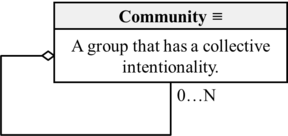Community Can Have Subcommunities (Overgaard-2017)
This is a theory that states "A community can consist of other communities."
Community Can Have Subcommunities was formulated by Nicholas Overgaard in 2017.1
Contents
Scientonomic History
Acceptance Record
Suggestions To Accept
Here are all the modifications where the acceptance of this theory has been suggested:
| Modification | Community | Date Suggested | Summary | Verdict | Verdict Rationale | Date Assessed |
|---|---|---|---|---|---|---|
| Sciento-2017-0013 | Scientonomy | 19 May 2017 | Accept that communities can consist of other communities, i.e. that there is such a thing as a sub-community. | Open |
Questions Answered
Community Can Have Subcommunities (Overgaard-2017) is an attempt to answer the following questions: Associations of Community.
Description
When dealing with a community, it might be useful to analyze it in terms of its constituent subcommunities (e.g. the community of particle physicists within the community of physicists). But such an analysis is based on an assumption that a community can consist of other communities, i.e. subcommunities. This assumption is by no means trivial; indeed, there might exist a view that each community is to be treated separately as one indivisible whole and, thus, any talk of its constituents is meaningless. According to Overgaard, communities can be said to be consisting of other communities.1p. 58 Thus, there is such a thing as a subcommunity, i.e. a community that is part of a larger community.
Reasons
No reasons are indicated for this theory.
If a reason supporting this theory is missing, please add it here.
References
- a b Overgaard, Nicholas. (2017) A Taxonomy for the Social Agents of Scientific Change. Scientonomy 1, 55-62. Retrieved from https://www.scientojournal.com/index.php/scientonomy/article/view/28234.
